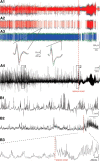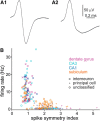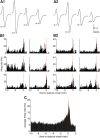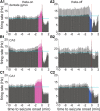Unit Activity of Hippocampal Interneurons before Spontaneous Seizures in an Animal Model of Temporal Lobe Epilepsy
- PMID: 25904809
- PMCID: PMC4405565
- DOI: 10.1523/JNEUROSCI.4786-14.2015
Unit Activity of Hippocampal Interneurons before Spontaneous Seizures in an Animal Model of Temporal Lobe Epilepsy
Abstract
Mechanisms of seizure initiation are unclear. To evaluate the possible roles of inhibitory neurons, unit recordings were obtained in the dentate gyrus, CA3, CA1, and subiculum of epileptic pilocarpine-treated rats as they experienced spontaneous seizures. Most interneurons in the dentate gyrus, CA1, and subiculum increased their firing rate before seizures, and did so with significant consistency from seizure to seizure. Identification of CA1 interneuron subtypes based on firing characteristics during theta and sharp waves suggested that a parvalbumin-positive basket cell and putative bistratified cells, but not oriens lacunosum moleculare cells, were activated preictally. Preictal changes occurred much earlier than those described by most previous in vitro studies. Preictal activation of interneurons began earliest (>4 min before seizure onset), increased most, was most prevalent in the subiculum, and was minimal in CA3. Preictal inactivation of interneurons was most common in CA1 (27% of interneurons) and included a putative ivy cell and parvalbumin-positive basket cell. Increased or decreased preictal activity correlated with whether interneurons fired faster or slower, respectively, during theta activity. Theta waves were more likely to occur before seizure onset, and increased preictal firing of subicular interneurons correlated with theta activity. Preictal changes by other hippocampal interneurons were largely independent of theta waves. Within seconds of seizure onset, many interneurons displayed a brief pause in firing and a later, longer drop that was associated with reduced action potential amplitude. These findings suggest that many interneurons inactivate during seizures, most increase their activity preictally, but some fail to do so at the critical time before seizure onset.
Keywords: CA1; CA3; dentate gyrus; local field potential; subiculum; theta.
Copyright © 2015 the authors 0270-6474/15/356600-19$15.00/0.
Figures











Similar articles
-
Preictal activity of subicular, CA1, and dentate gyrus principal neurons in the dorsal hippocampus before spontaneous seizures in a rat model of temporal lobe epilepsy.J Neurosci. 2014 Dec 10;34(50):16671-87. doi: 10.1523/JNEUROSCI.0584-14.2014. J Neurosci. 2014. PMID: 25505320 Free PMC article.
-
Role of CA3 theta-modulated interneurons during the transition to spontaneous seizures.Exp Neurol. 2016 Sep;283(Pt A):341-52. doi: 10.1016/j.expneurol.2016.06.027. Epub 2016 Jun 25. Exp Neurol. 2016. PMID: 27353968
-
Activation of hypoactive parvalbumin-positive fast-spiking interneurons restores dentate inhibition to reduce electrographic seizures in the mouse intrahippocampal kainate model of temporal lobe epilepsy.Neurobiol Dis. 2024 Dec;203:106737. doi: 10.1016/j.nbd.2024.106737. Epub 2024 Nov 13. Neurobiol Dis. 2024. PMID: 39542222
-
On the role of somatostatin in seizure control: clues from the hippocampus.Rev Neurosci. 2003;14(3):285-301. doi: 10.1515/revneuro.2003.14.3.285. Rev Neurosci. 2003. PMID: 14513869 Review.
-
[Neural mechanism underlying generation of synchronous oscillations in hippocampal network].Brain Nerve. 2008 Jul;60(7):755-62. Brain Nerve. 2008. PMID: 18646615 Review. Japanese.
Cited by
-
GABAA signaling, focal epileptiform synchronization and epileptogenesis.Front Neural Circuits. 2022 Oct 5;16:984802. doi: 10.3389/fncir.2022.984802. eCollection 2022. Front Neural Circuits. 2022. PMID: 36275847 Free PMC article.
-
GABAergic networks jump-start focal seizures.Epilepsia. 2016 May;57(5):679-87. doi: 10.1111/epi.13370. Epub 2016 Apr 8. Epilepsia. 2016. PMID: 27061793 Free PMC article. Review.
-
Disrupting Epileptiform Activity by Preventing Parvalbumin Interneuron Depolarization Block.J Neurosci. 2021 Nov 10;41(45):9452-9465. doi: 10.1523/JNEUROSCI.1002-20.2021. Epub 2021 Oct 5. J Neurosci. 2021. PMID: 34611025 Free PMC article.
-
GettING in Touch With What Drives Your Inner Funky: Sources of CA1 Gamma Oscillations.Epilepsy Curr. 2015 Sep-Oct;15(5):271-3. doi: 10.5698/1535-7511-15.5.271. Epilepsy Curr. 2015. PMID: 26448733 Free PMC article. No abstract available.
-
Dynamic, Cell-Type-Specific Roles for GABAergic Interneurons in a Mouse Model of Optogenetically Inducible Seizures.Neuron. 2017 Jan 18;93(2):291-298. doi: 10.1016/j.neuron.2016.11.043. Epub 2016 Dec 29. Neuron. 2017. PMID: 28041880 Free PMC article.
References
-
- Ben-Ari Y, Krnjević, Reinhardt W. Hippocampal seizures and failure of inhibition. Can J Physiol Pharmacol. 1979;57:1462–1466. doi: 10.1139/y79-218. - DOI
Publication types
MeSH terms
Substances
Grants and funding
LinkOut - more resources
Full Text Sources
Medical
Miscellaneous
